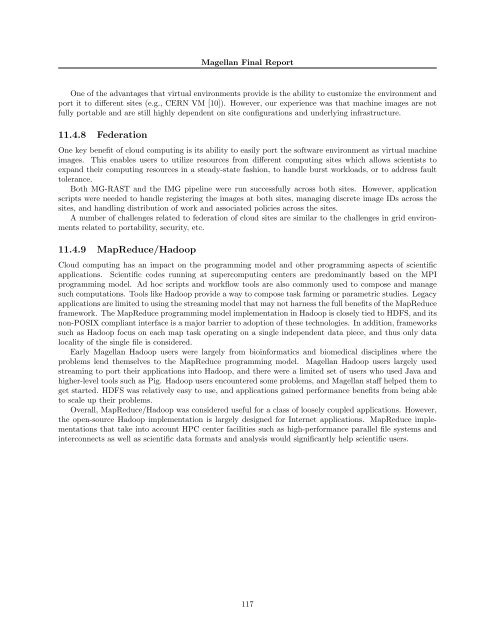Magellan Final Report - Office of Science - U.S. Department of Energy
Magellan Final Report - Office of Science - U.S. Department of Energy
Magellan Final Report - Office of Science - U.S. Department of Energy
Create successful ePaper yourself
Turn your PDF publications into a flip-book with our unique Google optimized e-Paper software.
<strong>Magellan</strong> <strong>Final</strong> <strong>Report</strong><br />
One <strong>of</strong> the advantages that virtual environments provide is the ability to customize the environment and<br />
port it to different sites (e.g., CERN VM [10]). However, our experience was that machine images are not<br />
fully portable and are still highly dependent on site configurations and underlying infrastructure.<br />
11.4.8 Federation<br />
One key benefit <strong>of</strong> cloud computing is its ability to easily port the s<strong>of</strong>tware environment as virtual machine<br />
images. This enables users to utilize resources from different computing sites which allows scientists to<br />
expand their computing resources in a steady-state fashion, to handle burst workloads, or to address fault<br />
tolerance.<br />
Both MG-RAST and the IMG pipeline were run successfully across both sites. However, application<br />
scripts were needed to handle registering the images at both sites, managing discrete image IDs across the<br />
sites, and handling distribution <strong>of</strong> work and associated policies across the sites.<br />
A number <strong>of</strong> challenges related to federation <strong>of</strong> cloud sites are similar to the challenges in grid environments<br />
related to portability, security, etc.<br />
11.4.9 MapReduce/Hadoop<br />
Cloud computing has an impact on the programming model and other programming aspects <strong>of</strong> scientific<br />
applications. Scientific codes running at supercomputing centers are predominantly based on the MPI<br />
programming model. Ad hoc scripts and workflow tools are also commonly used to compose and manage<br />
such computations. Tools like Hadoop provide a way to compose task farming or parametric studies. Legacy<br />
applications are limited to using the streaming model that may not harness the full benefits <strong>of</strong> the MapReduce<br />
framework. The MapReduce programming model implementation in Hadoop is closely tied to HDFS, and its<br />
non-POSIX compliant interface is a major barrier to adoption <strong>of</strong> these technologies. In addition, frameworks<br />
such as Hadoop focus on each map task operating on a single independent data piece, and thus only data<br />
locality <strong>of</strong> the single file is considered.<br />
Early <strong>Magellan</strong> Hadoop users were largely from bioinformatics and biomedical disciplines where the<br />
problems lend themselves to the MapReduce programming model. <strong>Magellan</strong> Hadoop users largely used<br />
streaming to port their applications into Hadoop, and there were a limited set <strong>of</strong> users who used Java and<br />
higher-level tools such as Pig. Hadoop users encountered some problems, and <strong>Magellan</strong> staff helped them to<br />
get started. HDFS was relatively easy to use, and applications gained performance benefits from being able<br />
to scale up their problems.<br />
Overall, MapReduce/Hadoop was considered useful for a class <strong>of</strong> loosely coupled applications. However,<br />
the open-source Hadoop implementation is largely designed for Internet applications. MapReduce implementations<br />
that take into account HPC center facilities such as high-performance parallel file systems and<br />
interconnects as well as scientific data formats and analysis would significantly help scientific users.<br />
117

















